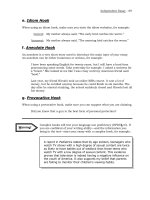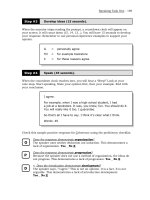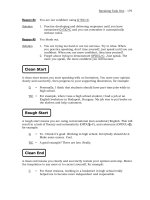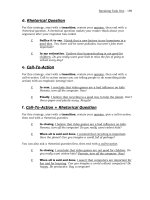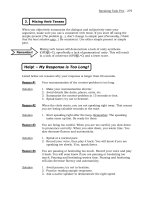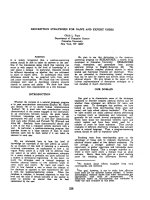Forex Strategies for High and Low Volatility Markets_1 pptx
Bạn đang xem bản rút gọn của tài liệu. Xem và tải ngay bản đầy đủ của tài liệu tại đây (700.97 KB, 32 trang )
This page intentionally left blank
CHAPTER
The Why of
Price Valuation
F
undamental analysis focuses on the why of price valuation
for a stock, an index, or a currency. Multiple factors affect
the value of an asset or market, and in this part of the book we
attempt to explain those factors in simplified terms. We need
to be aware that fundamentals move the market on both the
short-term and long-term levels because that can provide the
basis for a trading decision. However, when it comes to exe-
cution, which involves the when and the how in the trading
equation, we rely on additional information to supplement the
fundamentals.
Fundamental analysis historically has been used to evaluate
the worth of a company by valuing its stock price. As we have
seen new markets emerge and new financial instruments
develop, fundamental analysis has been used to price those
markets and instruments as well. When applied to the forex
market, fundamental analysis has a twofold purpose: deter-
mining the short-term impact on currency prices and forecast-
ing long-term trends. We will examine some of the underlying
21
2
forces that affect fundamentals. We’ve chosen to focus on
U.S. fundamentals because the U.S. dollar is involved in
approximately 70 percent of currency transactions. The over-
all generalizations we make about U.S. economic indicators
and U.S. interest rates apply in the same manner to other coun-
tries’ fundamentals and interest rates in relation to their cur-
rency valuations. Keep in mind that currency trading is relative
from currency to currency and economy to economy as the
business cycle evolves. When it comes to buying and selling
currencies at different times in the global business cycle, it is
not about identifying the strongest currency so much as it is a
matter of identifying the least weak currency.
Effect of the Business Climate
The same forces that affect the value of a business have an
impact on the price of currencies. In fundamental terms, a
company is valued on the basis of its balance sheet and cur-
rent or future income as well as intangible factors that will
affect that future income, including business model and plan,
management and leadership, competitive advantage, and
adherence to laws and regulations. External factors that affect
a company’s value include the valuation of the industry in
which it competes, the company’s rank or market share in that
industry, interest rates, and current or pending legislation that
will affect regulation of the industry. If a company’s products
or services are selling at a profit and are expected to continue
doing that and if other market conditions are favorable, that
company’s value, or stock, should go up. It is said that the
Mastering the Currency Market
22
company is fundamentally sound in those circumstances, and
the market reflects that value. If sales slow, expenses are
higher than expected, or external factors affecting profitabil-
ity change in a negative direction, the stock price should go
down. If sales are steady and the company makes no appre-
ciable gains, the stock may go sideways.
Similar concepts apply to countries and geographic unions. In
very simplified terms, if the companies and citizens in a country
are producing more than they spend and taxes are sufficient to
cover expenses, increased income in the form of tax receipts flows
into government coffers. Because most businesses continually
seek to improve, there is increased competition for money, or
funding, as individuals and businesses borrow money to expand.
An increased rate of borrowing money leads to increases in inter-
est rates, which will attract capital from investors seeking a
higher yield for their savings and investments and thus cause an
increase in tax receipts. Job growth is healthy when businesses
are spending money to stay competitive. In a healthy worldwide
environment, the stronger an individual country’s economy is,
the more demand there is for stocks and other investments
denominated in that currency, the more pressure there is for
higher interest rates, and the stronger the currency is. Conversely,
the slower the economy is, the more pressure it puts on stock
prices as investors exit investments in search of higher yields and
on central bankers to lower interest rates, further decreasing the
return on investments valued in that country’s currency; in that
case, the country’s currency becomes weaker.
To generalize about the impact of a positive global business
climate, it can be said that higher interest rates mean a stronger
currency and that a weaker currency leads to lower interest
The Why of Price Valuation
23
rates. The most direct link between interest rates and currency
values is the level of business activity. If business activity is
growing, there is room for higher interest rates created by
demand for more money and thus a stronger currency. If busi-
ness activity is contracting, higher interest rates are a threat to
commerce and interest rates may have to be lowered, with the
effect being a weaker currency.
In times of global economic uncertainty and recession, how-
ever, traders and investors favor lower-yielding currencies
because governments and businesses in those countries will be
relatively less handicapped by lower borrowing costs (interest
rates) in a slowing economic environment. In summer 2008 we
saw a good example of this as global stock markets turned lower,
erasing the gains of the previous two years. Investors around the
world went from thinking about the return on their investments
to being concerned about the return of their investments. With
governments, businesses, and individuals all trying to exit their
previously higher-yielding investments at the same time, cur-
rencies with higher-yielding interest rates fell sharply as money
poured out of the British, European, Canadian, Australian, and
New Zealand currencies and into the lower-yielding U.S. dollar
and Japanese yen. The sharp reevaluation of currencies in the
third and fourth quarters of 2008 also pointed out the fact that
the currency market is a self-correcting mechanism. What
strengthens a currency initially also can weaken it as interest
rates become too high and currency valuations become too
inflated relative to those of competing countries and unions.
Although Canadian citizens felt proud as their currency rose
from 0.60 to 0.80 against that of their U.S. neighbors, Canadian
businesspeople felt concern and then fear as the looney kept
Mastering the Currency Market
24
on strengthening from 0.80 to 1.00 against, or on par with, the
U.S. currency. This 40 percent increase in the looney made it
very easy for American farmers and manufacturers to take
business from their Canadian counterparts because the cost of
American feed and products was so much lower compared
with the Canadian than it had been just three or four years ear-
lier. As business shifted away from Canada, the looney turned
and was sold off, and the Canadian government cut interest
rates accordingly. Like a pendulum that has swung too far, it
can be said that the weight of a stronger currency can cause its
value to swing lower. It is this characteristic of a free enterprise
system with floating currency values that ideally ensures that
the best products and services at the most competitive prices
are what will set economic standards going forward, not polit-
ical or nationalistic considerations.
Interest Rates and the Carry Trade
As we saw with regard to the effects the overall business envi-
ronment has on currencies, interest rates play a key role. One
way to take advantage of interest rate differentials between
countries is by buying a currency with a higher interest rate and
collecting that interest and then selling a currency with a lower
interest rate; when the short position pays the interest rate, this
is called the carry trade. In times of global economic expansion,
investors and traders make money by using this strategy.
A typical example from a couple of years ago would be
buying U.S. dollars and selling Japanese yen; in trading par-
lance this is known as going long USDJPY. If interest rates
The Why of Price Valuation
25
were 3.0 percent in the United States and 0.5 percent in
Japan, the position would yield, or “carry,” an annual rate of
2.5 percent. If the trader had on a position of long five stan-
dard lots, or $500,000, he would collect 2.5 percent annually
on the $500,000 even if he had only $10,000 in his account.
That may sound like a lot of money at first, but consider the
risk that individual would be incurring to capture that $35 a
day in interest. By holding a $500,000 position in a $10,000
account, the trader could lose everything if USDJPY moved
just 2 percent. In today’s marketplace a 2 percent move in a
single day for a currency pair is not unreasonable. In a much
larger account, in a healthy economic climate, and with the
account managed by professionals, this arbitrage strategy
makes a lot of sense. Professional traders understand this and
have taken advantage of interest rate differentials in the
global marketplace during times of economic expansion. For
an individual with little experience and a small account, the
strategy is inadvisable and dangerous.
The last time the carry trade was working, from mid-2005
to mid-2007, it was working very well. Prices of the higher-
yielding currencies raced higher while prices of the lower-
yielding currencies stood still or even moved lower. What this
meant was not only that buyers, or “longs,” in the carry trade
were capturing the interest on their positions but that they
were reaping the traders’ reward as their positions increased
in value. Individuals with little experience were accumulat-
ing larger and larger long positions and calling themselves
traders. You probably can guess how this ended. Prices plum-
meted violently at the beginning of 2008 as speculative
monies vanished when stock and real estate markets fell
Mastering the Currency Market
26
sharply after their inflated advances earlier in the decade.
After a long pause through the spring and early summer of
2008, the sell-off accelerated again in mid-2008 as carry trad-
ers with only a few years’ experience learned the hard way
that what goes up comes down. They also learned that earn-
ing a few pips a day on a carry trade was not trading at all.
The bright side of this situation for experienced traders was
that after the carry trade evaporated, two-way trade resumed.
After the majority of the speculative money was wiped out,
prices were free to move up and down, which is what mar-
kets do in normal conditions.
Inflation and Commodities
An important link between interest rates and currency values
is commodity inflation, which, unlike an individual area or
country’s business activity, affects all economies. As inflation
rises and prices spiral upward, some people quickly start to
buy up future supplies of basic necessities as insurance against
higher prices in the future. In that scenario, prices go up not
because of healthy business activity but because of uncertainty
and fear—and fear moves markets. In that scenario the gov-
ernment can increase the interest rate earned on cash deposits
to get individuals to sell off their stockpiles of supplies in
exchange for cash and the increased dividend created by
higher interest rates. This seems a responsible action but does
not work in all cases. Some individuals are inclined to hang
on to their supplies rather than take the cash, and attempts at
easing inflation can be thwarted.
The Why of Price Valuation
27
Businesses and economies around the world wrestled with a
very similar fundamental problem with the supply of crude oil
from 2005 through 2008. Crude supplies were shrinking as
worldwide demand increased, and that caused the price of
crude to jump from under $40 per barrel in 2004 to a high of
$140 in July 2008. That created additional expenses and com-
modity shortages and the fundamental complications that go
along with that situation. Those problems had not been in place
just a few years before. Countries that had their own supplies
of crude didn’t feel the need to raise interest rates, whereas
some countries and regions that did not have their own sup-
plies did. The interest rate differentials created opportunities for
traders but caused much confusion for the economists and
politicians charged with solving those complex problems.
Generally, a rise in commodity inflation will cause a rise in the
value of the currency of a country that has large supplies of that
commodity. Again, however, it is important to keep in mind that
currency valuations are relative. Many analysts and commenta-
tors called the Canadian and Australian currencies commodity
currencies because those countries have an abundant supply of
commodities, and as the price of commodities moved higher
from 2002 through 2008, so did those two currencies. The
United States also has an abundance of commodities, whereas
Switzerland does not, yet the U.S. currency went down and the
Swiss currency increased sharply over that period. This leads to
the question, was there really a relationship between commodi-
ties going up and these so-called commodity currencies going
up, or did they just happen to be different investment classes
that were going up at the same time? As it turned out, the
Canadian currency topped out a full seven months before crude
Mastering the Currency Market
28
oil peaked, whereas gold peaked four months ahead of the
Australian dollar. As of December 2008, gold was off its all-time
high by just 15 percent and the Australian currency was off its
high by 30 percent.
We believe that both commodities and currencies are com-
plex vehicles that should be traded individually on the basis of
price movement. There are relationships between different mar-
kets and asset classes, but relationships by definition change,
particularly when one is comparing complex pricing processes
such as commodities and currencies. “Don’t get caught trading
wheat in the corn pit” is an old Chicago trading adage. It can
be said that the same thing is true when one is trading a cur-
rency that is based on a commodity’s price or vice versa.
Commodity inflation overall adds uncertainty to markets
as governments try to offset the effects of rising and falling
prices with interest rate or other policy changes when often
it is best to let the markets correct themselves. Uncertainty
in the markets produces price movement, which is always
beneficial for traders.
Consumer Habits
One also must take into account the effects that prosperity and
the appearance of continued prosperity have on financial mar-
kets; this also is known as the boom-bust cycle. When economies
are strong, such as that of the United States in the 1990s and from
2003 through 2007, it creates the expectation that strong eco-
nomic growth will continue. As is often the case in economics
and markets, the seeds for the downturn were created by
The Why of Price Valuation
29
overoptimism during the upturn, as stocks were bid up to unrea-
sonably inflated valuations in the late 1990s, followed by the
same phenomenon in real estate in the 2000s. “Chicken today,
feathers tomorrow,” as the old saying goes. That means, “Don’t
worry about tomorrow; get what you want today.” This is a clas-
sic behavioral mannerism of many young adults during the first
half of their employment cycle. For many, it does not make fun-
damental sense to drive a large motor vehicle that gets poor gas
mileage or to take on a large home and mortgage in anticipation
of a promotion and monetary raise the next year.
More often than not, this leveraging of the future to get more
of a good thing in the present leads consumers to tip over
financially. The newspapers were full of these types of stories
in 2007 and early 2008, and they projected economic slow-
downs after extended periods of excess. The fact that many
people have excessive debt is projected to weigh on consumer
spending and therefore on business spending. The drying up
of consumer spending can affect a country’s currency, and
when the behavior is collective, the whole global marketplace
can feel the pinch. Excessive consumer spending without the
earnings to pay for it leads to a downward spiral brought on
by debt and unsound economic decisions made by countries’
primary consumers.
On a microeconomic level individuals are responsible for their
own finances, but on a macroeconomic level people look to gov-
erning bodies for help in a financial crisis. This is what happened
in the second half of 2008 and the beginning of 2009. Govern-
ments embarked on a policy of notching down interest rates so
that they could attempt to borrow their way out of trouble by
lending to and buying into industries and companies hurt by
Mastering the Currency Market
30
the uncertainty and fear created by falling stock prices and ane-
mic consumer and business spending. As of this writing, the jury
is still out on this strategy of governments keeping businesses
and industries afloat to ensure both employment and a tax base
and stabilize corporate securities markets. The thing to remem-
ber as traders is that we do not attempt to anticipate the effects
of this strategy in the financial marketplace. We let the market
tell us how it interprets these actions by seeing which signals are
proving profitable, the buy triggers or the sell triggers. We do
know this, though: The volatility created by economic uncer-
tainty is a feeding bell for professional traders.
There are many nuances in the fundamental valuations of
stocks, other financial instruments, and currencies, and we’ve
taken a look at the major ones. As we’ve seen, there are four
important factors in the pricing process for financial markets:
1. Current business conditions, meaning income and cash on
hand for companies
2. Interest rates, in which differentials between countries can
create market momentum
3. Inflation, in which the concern is whether inflation is
growing or ebbing
4. Individual spending habits, which are defined as housing
and disposable income
The bottom line in business and market valuations nearly
always is determined by fundamental developments. Funda-
mentals are the why of price action. There is no doubt about
the role a country or region’s capital flows and trade flows play
in determining currency prices.
The Why of Price Valuation
31
Below, we summarize the key economic reports and discuss
their impact on currency prices.
Key Economic Reports
Fundamental traders, economists, and market analysts gauge
economic activity by studying and interpreting economic
reports and readings released by companies and government
agencies. These news releases are available at a number of
online sites. We use www.ForexFactory.com, which is one of
the leading sites in the forex industry for news. On the front
page of its Web site there is a tab for “Calendar.” If you click
on that tab, it will show an extended list of economic releases
for the week and their expected impact. Releases with a red
icon have the highest expected level of impact. Another great
resource is www.munibondadvisor.com/EconomicIndica-
tors.htm, which links readers directly to the source for every
news release.
Figure 2-1 shows a summary spreadsheet of the most influ-
ential news releases for the United States, including the typi-
cal release dates and the net effect a release may have on the
U.S. dollar. Note that these are generalizations and cover only
one factor affecting currency prices. We do not recommend that
anyone trade ahead of a major news release, as the results can
be extreme and unpredictable.
The way traders react to these economic reports and releases
is always dynamic, and that is why they are covered exten-
sively on the financial news shows. Economic reports can rein-
force the existing trend as related releases confirm one another,
or the reports can contradict one another, which could indicate
Mastering the Currency Market
32
The Why of Price Valuation
33
Figure 2-1 Key Economic Reports and Leading Indicators
a possible change in underlying business conditions. The way
traders react to the reports in their positioning in the market-
place—their buying and selling—is also a very dynamic pro-
cess. A report came out that is indisputably market-friendly in
a mature up move, and traders may take this as a reason to take
a profit and sell. The traders’ reasoning may be “We were long
this market because of existing favorable conditions, and this
report proves our thesis was correct, so let’s take some money
off the table and put it in our pockets now because we don’t
know if things can get much better than this.” “A bird in the
hand is better than two in the bush” is standard operating
procedure for many who make a living risking their earnings
in the marketplace.
The way traders and markets react to the different funda-
mental news releases and events is a study in chaos. How many
contracts players trade and the direction in which they execute
their trades immediately after a fundamental news release may
have as much to do with the way they were positioned before
the news release as it does with what the actual news told them.
Herd mentality also plays a role as influential players may opt
to adjust or exit a position more because of the level at which
the market is trading than because of the actual fundamental
news. A large player making an adjustment to its long-term
position can have an outsized effect on a market that may trig-
ger price signals for other traders who operate on shorter-term
time frames. Also, there are always times when traders get
caught flat-footed after a surprising influential news release and
markets make sharp sustained moves, forcing even longer-term
traders into exiting positions without as much consideration
and time as they would like. Do not expect that after reading
a chapter in a book or even reading a series of books you will
Mastering the Currency Market
34
understand all the factors that affect releases of economic num-
bers. Over time and through experience, however, you will start
to understand these pieces of the puzzle and the way they
relate, if at all, to your trading plan. Let’s define some signifi-
cant fundamental releases and see the effects they have on the
different markets.
Nonfarm Payroll
The nonfarm payroll reports the amount of jobs added to or
subtracted from the U.S. economy in the nonagricultural sec-
tors over the previous month. It is released on the first Friday
of the month. It can have an outsized effect on markets because
it is considered a very influential reading on economic health.
This number is reported by the U.S. Department of Labor,
Bureau of Labor Statistics, at www.bls.gov.
Figures 2-2 and 2-3 show the powerful effects of the nonfarm
payroll number on June 6, 2008, in both the U.S. stock market
and the EURUSD market. The report indicated a sharp drop in
payrolls accompanied by a 0.5 percent jump in the unemploy-
ment rate and had an outsized effect on stock prices and the
U.S. dollar. The Dow Jones Industrial Average fell approximately
400 points, and the euro ended up benefiting from the bad news
by pulling out of a downtrend and rallying over 2 points.
The Federal Open Market Committee
The Federal Open Market Committee (FOMC) has consider-
able influence on all financial markets because it is this gov-
erning body of the Federal Reserve Board that sets interest
rate policy. The committee reports on interest rate decisions
The Why of Price Valuation
35
by the Federal Reserve Bank (the Fed) and gives traders valu-
able insights into the Fed’s decision-making process through
those reports. The committee meets eight times a year, and
there is an announcement after the close of each meeting.
A change in the federal funds rate (the rate at which banks
lend money to each other) as mandated by the Fed affects
interest rates across the board and can have a major impact
on business decisions across a wide range of businesses and
industries. The results for the FOMC meetings are reported
on the Federal Reserve Web site at www.federalreserve.gov.
Mastering the Currency Market
36
Figure 2-2 Effects of a Higher Than Expected Unemployment Figure on the
U.S. Stock Market
Always remember that in general a decision to raise interest
rates will be U.S. dollar-friendly and a decision to lower rates
will be U.S. dollar-bearish.
Figure 2-4 shows an initially bearish reaction for the dollar
as the USDJPY was sold off when the FOMC announced that
it would leave interest rates unchanged rather than raise them
in the face of rising commodity inflation, as some economists
were recommending. In this case the initial knee-jerk reaction
lower was short-lived as USDJPY continued on its previous
path higher.
The Why of Price Valuation
37
Figure 2-3 Effects of Higher Than Expected Unemployment Figure
on EURUSD
Durable Goods
The monthly report on durable goods indicates the value of
orders received by U.S. domestic manufacturers for big-ticket
items with a life expectancy of more than three years such as
motor vehicles, appliances, and computers. The release comes
out at the end of every month and is a compiled from a vari-
ety of sources. The figures on durable goods are released by the
U.S. Census Bureau and can be found on its Web site at
/>Mastering the Currency Market
38
Figure 2-4 Initial Reaction to FOMC Announcement Was Short-Lived
Figure 2-5 shows an example of a durable goods release that
kept GBPUSD pointed lower. This is an example in which a
market already had taken a direction and the report served to
reinforce that existing bias.
Retail Sales
The monthly report on retail sales provides a reading on retail
activity over the previous month that gives investors insight
into consumer spending habits. The figures on retail sales are
The Why of Price Valuation
39
Figure 2-5 Better Than Expected U.S. Durable Goods Report Reinforces
Current Trend
released by the U.S. Census Bureau and can be found on its
Web site at www.census.gov. Figure 2-6 shows a good exam-
ple of a mature up move in a dollar-based pair. Traders took
advantage of a dollar-friendly news release—a better than
expected U.S. retail sales number—to exit their long positions,
putting a temporary top in the market for that session.
Gross Domestic Product
The gross domestic product (GDP) is a measure of national
income and output for the economy. It generally covers the pre-
vious quarter and then is annualized, and so it tends to be a
Mastering the Currency Market
40
Figure 2-6 Traders Take Profit on Better Than Expected U.S. Retail
Sales Release
lagging indicator. The textbook example for a recession is two
straight quarters of negative GDP growth. We did not provide
a graphic example for the U.S. GDP because the market rarely
has a strong reaction to a U.S. GDP release, having taken its
measurements and made its reactions from the more timely
economic indicators. Figure 2-7 shows a chart for GBPUSD
after a Great Britain GDP release that came in at zero growth
and reinforced an existing downtrend.
The Producer Price Index
The producer price index (PPI) measures changes in the prices
received by producers for their output. It is a key indicator in
The Why of Price Valuation
41
(GBP A0-FX - UK STERLING, 120) Dynamic,0:00-24:00
Great Britain Industrial Production
Comes in at 0.0% growth vs. 0.3% expected
Great Britain GDP comes in
at 0.0% vs. 0.1% expected
Negative fundamental measurements reinforce existing
down–trend as Pound weakens and U.S. Dollar strengthens
Figure 2-7 Fundamental Releases Support Existing Down Trend
determining inflation on the production level. This number is
reported by the U.S. Department of Labor, Bureau of Labor Sta-
tistics, at www.bls.gov. Generally, a higher than expected U.S. PPI
release leads to U.S. dollar strength, as the expectation is that
interest rates will be raised to combat inflation. Figure 2-8 shows
an example of a slightly higher than expected PPI release, after
which the U.S. dollar strengthens initially and the euro weakens.
Once the selling dries up, the market still finds itself above the
previous week’s low price, and traders opt to take profits at the
146.50 level by buying back their short positions. This puts sup-
port in the market, and we see a rally going forward on what ini-
tially was taken as a bearish fundamental release for EURUSD.
Mastering the Currency Market
42
Figure 2-8 Despite Bearish News, EURUSD Reverses on Support after
Dollar-Friendly News
The Consumer Price Index
The consumer price index (CPI) measures the average price of
consumer goods and services bought by households. It is a key
indicator in determining inflation on the retail level, as cost of
living elements are factored into the prices. As with many other
reports, there are multiple segments, but it is best to focus on
the core rate and avoid being distracted by other segments.
This number is reported by the U.S. Department of Labor,
Bureau of Labor Statistics, at www.bls.gov.
A higher than expected CPI release generally leads to
strength in the U.S. dollar. Figure 2-9 shows a USDCHF chart
The Why of Price Valuation
43
Figure 2-9 Initial Knee-Jerk Reaction Lower on Higher CPI Data Proves
Short-Lived
in which there is a knee-jerk reaction lower to a CPI number
that was higher than expected. However, once the price settles
down and finds support around the previous session’s low, the
market turns and trades higher, in line with the higher than
anticipated U.S. inflation numbers.
Consumer Confidence
The index of consumer confidence measures the level of eco-
nomic optimism of consumers, based on their savings and spend-
ing activities; it generally is released on the last Tuesday of the
month by The Conference Board at www.conference-board.org.
Mastering the Currency Market
44
Figure 2-10 Higher Than Expected Consumer Confidence Data Support
Existing Trend

